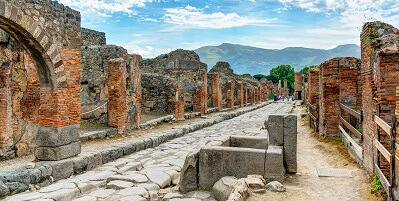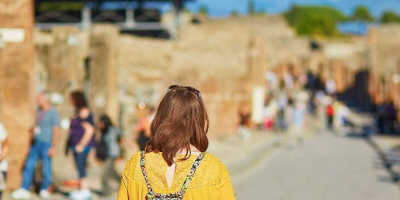Top Things to do in Pompeii
Located near Naples in Italy, you can spend a whole day exploring Pompeii, or even a day in a half. If you find your time a little more stretched, then follow this list of main highlights to make the most of your visit!
The vast archaeological site of Pompeii is famous around the world. People travel from all over to walk the same steps of those who lived during ancient Roman times. Both destroyed and preserved by the volcanic eruption of Mount Vesuvius, this once lost city remains, offering a perfect snapshot of life 2000 years ago. With incredible attractions that illustrate the society that thrived here, Pompeii is a marvel and must-see. Here is a quick look at some of the key places you need to check out!
Best Things to do in Pompeii
-
Amphitheatre
The oldest roman amphitheatre to date, this theatre once seated a whopping 20, 000 people. It was said to be an incredibly popular place for the Pompeii people, with past entertainments including the renowned gladiators’ games. With the top section of the amphitheatre still intact, take a seat and be transported back to the ancient times of Pompeii. Located at the far end of Pompeii, there are few other tourists visiting the amphitheatre, especially in the morning and late afternoon, which gives the arena an eery feel to it. A place once filled with energy, excitement and death, it seems strange that it now stands silent, one of the quietest places on site.
-
Brothels of Pompeii
If you are interested in a more tantalising venture, why not visit the ancient brothels of Pompeii? The historic city was a thriving place for the wealthy, with luxurious indulgences including the houses of pleasure. Although the Pompeii people displayed these brothels as an erotic and exotic treat, the reality of the sex worker’s lives are quite tragic. Many of the workers were slaves who worked in tiny cells, only big enough for a small stone bed. Despite this heartbreaking past, these structures are still worth seeing. Beautifully preserved, with erotic art painted on the walls, displaying the services provided for this historic community. One of the only confirmed brothels is lupanar, and unsurprisingly one of the most visited houses in all of Pompeii.
-
Public Baths
Bathing was a major part of Roman culture and Pompeii was no exception. A communal activity the public Baths offered citizens a place to get clean and refresh themselves after a day of work. They were similar sizes to public pools today, with separate baths for women, men, and slaves and sometimes courtyards, acting as an outdoor pool. And like leisure centres or health clubs in the modern-day, the public baths were a place people could socialise, meet up after work or even have business meetings whilst they soaked. Incredibly preserved, the best two public baths you can see at the archaeological site include the Forum Baths and the Stabian Baths, both with their own unique features.
-
The Villa of Mysteries
The Roman villa of Mysteries is one of the most popular attractions in Pompeii. It is incredibly well-preserved, with astonishing frescoes still displaying surprisingly vibrant colours. With a series of frescoes lining the wall that are thought to describe a single story, the images have been interpreted as a woman entering into the initiations of a Greco-Roman cult ritual. Situated on the outskirts of the city the villa takes about half an hour to walk to. However, the amazing scenery of the area is well worth the stroll.
-
House of the Small Fountain
Although this attraction is small, it holds a great amount of beauty. Once a past home to a rich family, the villa is filled with stunning architecture, preserved frescos, as well as the famous fountain. The fountain is the main reason tourists venture here, decorated with colourful mosaics and shells, and a small bronze statue, the fountain is another beautiful example of Roman architecture. The stunningly ornamented fountain was once a popular fashion feature in ancient times and shows us the incredible detail Pompeiians put into their work. The sloped roof of the building also reveals how rainwater was used to fill the fountain, an incredibly innovative idea for that time.
-
Garden of the Fugitives
Located in the back of Pompeii, this old vineyard is the resting place of thirteen victims who didn’t make it out alive. Fascinating, yet unsettling, these plaster casts reflect the dramatic events that took place following the eruption as people unsuccessfully tried to flee. It revives the horror of the tragic death suffered by Pompeii’s inhabitants. Frozen in differing positions, the bodies are shown to be lying on the ground, either taken out by the forces around them or cowering in terror. Among them are children, as seen by their small bodies.
-
Herculaneum
Once you have seen everything Pompeii offers, why not travel to the small, wealthy village of Herculaneum? Due to being around about a half an hour drive from Pompeii, the village had more time to react to the oncoming destruction, with most of the inhabitants escaping before the town was similarly swallowed by a storm of ash. The town is rich in preserved beauties, and due to its size, is a less crowded area to venture into. It was here that developments were made concerning what the people of ancient Rome ate. With over 700 sacks of human waste excavated, huge insights were made into their diet, jobs and illnesses.














